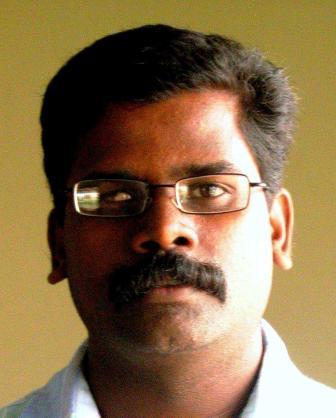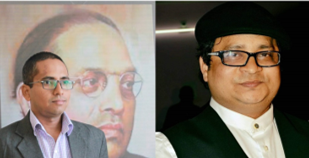B. Prabakaran
 “A religion which does not recognize man as man is not religion but a disease” ~ Dr. Ambedkar.
“A religion which does not recognize man as man is not religion but a disease” ~ Dr. Ambedkar.
Gujarat government has retracted four lakh books on Ambedkar titled, Rashtriya Mahapursh Bharat Ratna Ambedkar, the standard title used by Hindu groups for Ambedkar, which was expected to be given out to school students across the state. The reason for the decision was, as reported by the print media, because of the inclusion of (in the appendix part) the twenty two vows of Ambedkar, which he openly affirmed in front of his counterparts from different parts of India on the day of his conversion to Buddhism in 1956. In order to avoid the ire of the ruling party, no paper except Theekkathir, the communist party’s paper, has published the news item in Tamil, as if it is extraneous to the public interest.
The Social Justice and Empowerment Ministry of Gujarat state announced that the vows of Ambedkar, particularly the vows negating Hindu gods and condemning inequality of Hinduism, simmered with anti-Hindu content in nature, which would spoil young minds if they happen to read it. However, the incident reaffirms that Hinduism had to lay down its arms before Buddhism once more. On the one hand, the sixtieth anniversary of Ambedkar’s conversion commences this October 2015; while on the other hand, the programme of Ghar Wapsi is getting more vitriolic in Hindu India. At this juncture, we can ask ourselves to what extent the unending conversions of Dalits to Buddhism or any religion are a useful idea.
Ambedkar was one of the strongest critics of Hinduism, among other radicals and reformers of India. He also criticized other religions such as Islam, Christianity, Sikhism and Buddhism. For Ambedkar, religion was the social force which binds people together as a single group or community. Despite the fact that Ambedkar explicated what is religion from his personal point of view and from a sociological perspective, he has been characterized as an atheist, an intensely religious person as well an iconoclast by Ambedkarities, theologians, scholars and the general public. But his views on religion are based on the question – to what extent does a religion give liberty, equality and fraternity to the poor and the oppressed? Throughout his career he negates Hinduism, as a divisive element, which does not have any moral doctrines. He charged, “What the Hindus call religion is really Law or at best legalized class-ethics. Frankly, I refuse to call this code of ordinances, as religion.” Timothy Fitzgerald, who studied Ambedkar’s Buddhism comprehensively, in Maharashtra observed, “he was an intensely religious man in the sense of having deep commitment to values and principles, such as compassion, justice and equality'”.
In the 90s, during the celebrations of the Ambedkar centenary year D.R.Nagaraj, a Kannada scholar, wrote in his famous essay (in order to bridge the gulf between Ambedkar and Gandhi) that Ambedkar and Gandhi influenced as well transformed each other. Above all Gandhi, he assessed, influenced Ambedkar to accept the primacy of religion in the matter of untouchability. Is this hyperbole or have we hitherto really failed to understand this truth or is it purely Nagaraj’s own postulation? However, if it is true then that would be the focal point to understand the politics of religion of Ambedkar.
Gandhi openly calls himself a sanatan Hindu, he believed in Hindu scriptures and their authority. He propagated cow worship and the need for its protection. He admired the varna system as a very good institution which, in his perception, we were expected to follow. For Ambedkar, inequality was the soul of Hinduism. There would be no Hinduism without inequality. He negated the authority of Hindu scriptures, and instead suggested abolishing shastras to annihilate caste. Moreover, Ambedkar calls everyone to clean their minds from the pernicious notions found in the shastras. Hinduism, for Gandhi, is based on equality. To Ambedkar, it is relatively conflicting for ‘to be a Hindu means not to mix, to be separate in everything’. Gandhi emphasized elsewhere, a Brahmin, an ant, an elephant and an Untouchable – all are equal in status. Ambedkar honestly put his estimation of Hinduism from his own experience that ‘if I am equal before God, why am I not equal on earth’.
By all means Ambedkar and Gandhi were not getting along well on the subject of religion and had different ideas in other matters too. To say Gandhi influenced Ambedkar is, perhaps, a paradoxical statement. At the same time we agree that in his conversion part Gandhi could sway Ambedkar to make the choice of Buddhism – as an Indian born religion.
The relationship between Ambedkar and Buddhism starts from his school days after he received a Marathi book about Buddha, as a gift for passing matriculation examination, from his father’s friend Keluskar. He was barely sixteen at the time. Later, as an intellectually mature person and a voracious student of religion, he named his house as Rajgriha – place of Buddhist kings – and the college he started as Siddhartha – Buddha’s family name. All his remaining life, he wanted to propagate Buddhism all over the world. He travelled around India, Nepal, Burma and Sri Lanka to preach, and to visit Buddhist historical monuments. In the course of his visit to south India he found an outstanding manuscript on Buddhism – The Essence of Buddhism by Prof. Lakshmi Narasu. He realized in a little time the need for republishing the book and he did it with his introductory notes. Most of all, he proved in his theory on the origin of ‘The Untouchables’ that the untouchables were avid followers of Buddha since the fourth century even though Brahmanism repressed them to leave Buddhism. For this reason they were relegated as untouchables, while others were forced to repudiate Buddha and his Dhamma.
Ambedkar, indeed, had no plans when he announced that ‘I will not die as a Hindu’. At some stage, before the announcement he was distrustful of Gandhi and the other Hindu leaders. In consequence, this situation made him to pronounce the statement against the Hindu majority. Following the Yeola announcements, many protests and a campaign were held against this decision by Ambedkar to not remain a Hindu, and also because of the proliferation of his followers. Even Congress and Hindu Mahasabha had negotiated with Ambedkar to get him to reverse his decision. Religion, Gandhi suggested, cannot be changed as a cloak. Moonje’s suggestion to Ambedkar was for embracing Sikhism which, if he took it up, would offer the same identity as Hindu and shall get reservation under the Hindu category. M. C. Rajah, the rival of Ambedkar, refused his call by arguing against it. Ambedkar decided steadfastly that conversion would be a solution for the political life of Dalits and their future in Hindu India.
What conversion means for Dalits after Ambedkar’s adoption of Buddhism is the central question today. Most Dalits regard that to follow Ambedkar or become his disciple and embracing Buddhism is equivalent. So they do it every year on April 14th and October 14th, at least symbolically or as some call it ritually. Embracing any religion or Buddhism only because Ambedkar did so would be an idiocy as he warned. Neo-Buddhism has touched us through books, pamphlets, workshops and discussions organized by mostly converted Buddhists or Buddhist organizations. As a literate but as poor and oppressed people, we read and imbibe Buddha as a revolutionary or at least a radical. However, in our social lives we do not know the essence of Neo-Buddhism, how much are we able to follow his ideas or principles.
Can only a literate person understand what is said in Buddha and his Dhamma – the magnum opus of Ambedkar or the Buddhist Bible? The teachings of Buddha have not reached the margins of our society passably, for which we need a preparation for social action, though we proclaim Dalits as ‘Adi Buddhist’ or Non-Hindus among Hindus. We need to ask, in addition to Ambedkarism, to what extent Buddha is required, religiously, for annihilation of caste.
While liberation theology explains god as a liberator and he/she (or both) is on the side of powerless in the struggle against power, authority and hegemony or any sort of oppression, Ambedkar’s Buddhism does not waste its time in interpreting the existence of god theologically. Instead it tries to change the world or make us transform the oppressive structures. Neo-Buddhism possibly can have many meanings or interpretations. We may call it as Doing Theology for the liberation of Dalits or any marginalized section.
Ambedkar, in his interpretation, gave much importance to moral principles rather than sacred things as other religions do. The question here is how morality can become a religion to the masses. Ambedkar placed Dhamma as a basis for justice, and also as an unconventional gospel as opposed to the existing oppressive Brahminical gods or Brahmanised gods. If we could follow the Dhamma, as Buddha did, from Ambedkar’s point of view, it is to give importance to the relationship between humans, which would be a unique religious life that does not need any god or goddess.
Buddha and his Dhamma can surely be a complete guide for newly converted Dalits and of course to the old Buddhists but it does not talk about annihilation of caste as part of the structure of Dhamma. Though Ambedkar’s exegesis covers key subjects of Buddhism, to reinterpret the traditional understanding of Buddha and provide a moral path to Dalits and for the entire world, he omits the chapter on caste. He might have thought it was not so important in the context of Buddha and his Dhamma, as he had previously discussed broadly on caste and its pernicious effects on society, especially on Dalits.
At this stage, we can ask two questions that seem relevant today – who Buddha is for Dalits, and how Buddhism can be a remedy for Dalits who face almost every day humiliation, exclusion and oppression. How do we replace folk deities/religion, which Dalits worship with more sensible and intense happiness for centuries? If Buddhism is anti-caste, then notably some folk religions comprise more anti-caste components that counteract Brahmanism at every level. However, the bitter thing is that those deities have also been Brahmanised today. Some Dalits who have converted as Buddhist earlier, now also worship Hindu gods, especially in Maharashtra and other regions too, taking active part in Shiv Sena, RSS and BJP. Other Dalits, who converted to Islam and Christianity, also encounter untouchability at various levels in their religious life. As a result, they are same as in the case of other ‘outcastes’ in India.
Dalits, to some extent, indeed were/are able to move away from the oppressive Hinduism to a rational faith, ideologically if not theologically, but they tend to forget the cultural element of religion in Buddhism. Therefore, Buddhism must explicitly take the form of culture of anti-caste at all levels; otherwise it would not succeed in countering the Hindu majority. These days mobilizing Dalits within Hindu fold is being done with greater force than ever before (for which they constantly use Ambedkar). We all might have seen last week how Dalits and their neighbourhoods were being utilized for the Vinayak Chaturthi yatra and celebrations. RSS propagated recently, though it is impracticable, those who reconvert to Hinduism shall be free to choose their caste (in the hierarchy) even outside their own caste. They also urged capital punishment for conversion. As Hindu groups are trying to fill the cultural gap among us, it is utmost important to bring Buddhism as a culture into the everyday life of Dalits, and it cannot happen individually, and has to happen collectively. If Dalits are not collectively resisting as Buddhist, Hinduisation of dalits would be inevitable and the conversion would remain or become merely a ritual.
I am indebted to Meena and Abarajit Singh Kumar of MIDS, Chennai, for sharing their comments and valuable suggestions to the earlier version.
~~~
B. Prabakaran is a Researcher, Author of two books on Ambedkar.
prabakar.bas@gmail.com










